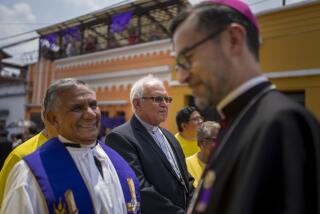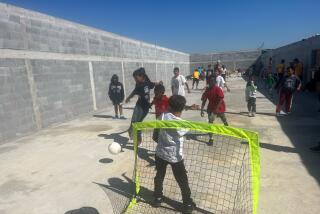Nun’s piercing memoir of torture and her quest for the truth
Sister Dianna Ortiz, a young Ursuline nun, moved from Kentucky to Guatemala to work as a missionary in 1987. She was set on serving the indigenous people of the area. “I’m more convinced than ever that God is calling me to live with the Guatemalan people in a lifestyle consistent with their mode of life,” she wrote to a friend. In San Miguel Acatan she taught youngsters the basic skills they’d need to begin first grade, using an interpreter who spoke the native dialect, K’anjobal.
Her support of the dialect may have been seen as subversive by the Guatemalan army’s counterinsurgency force, since it strengthened Mayan ties and Mayans were considered the natural allies of the guerrillas fighting the country’s government. Or maybe, simply by providing services to those in need, she helped the wrong people. “We had youth meetings, music meetings and catechetical meetings.... We could have met with people who were guerrillas -- and we wouldn’t have known it,” a fellow missionary notes. Perhaps hers was a case of mistaken identity, or a scare tactic to get other missionaries to leave the area.
Whatever the reason, on Nov. 2, 1989, Ortiz was kidnapped by security forces, taken to a secret prison and brutally tortured. Her piercing memoir, “The Blindfold’s Eyes: My Journey From Torture to Truth,” is a portrait both of the horrific torture she endured and the twofold tribulation that continues to this day as she struggles to survive the flashbacks that threaten to defeat her and as she works against stonewalling by both the Guatemalan and U.S. governments in her quest for the truth.
During her 24-hour captivity, Ortiz was burned nearly 100 times with cigarettes, gang-raped and suspended over a pit of bodies of those who had been murdered and those who were still dying. She was also forced to hold her hands on a knife as her torturers plunged it into another woman, and was videotaped in the process so that she could be blackmailed.
She escaped, came back to America and is still working to recover her life and her faith in humankind.
In the years following her ordeal, Ortiz was placed under psychiatric care, unable to remember anything of her life from the time before the nightmare; close friends and family members became strangers. While she recovered, she was regularly stunned by the force of memories that left her wanting to die, and at one particularly low time, she considered suicide. Her narrative clearly depicts the excruciating path of healing for torture survivors.
The torture itself and its effects on her, though, make up only part of the book. The bigger story, and in some ways a more disturbing one, details the tribulations she endured at the hands of the U.S. and Guatemalan governments as she tried to find out exactly what had happened to her and why. The Guatemalan government, for example, initially called her abduction a case of staged “self-kidnapping” and, later, a hoax arranged so that she could meet a supposed lesbian lover.
Over the course of the narrative, Ortiz uncovers crucial information about “Alejandro,” a North American man who had access to the torture chamber, who gave orders to her torturers and who she is convinced had connections to the U.S. Embassy. She also identifies one of her torturers as a Guatemalan trained at the School of the Americas, a Ft. Benning, Ga., facility run by the U.S. government for training Latin American soldiers. This man, she believes, was taking orders from yet another soldier who, until recently, was on the CIA payroll. The can of worms she uncovers about U.S. actions in Guatemala (many done behind the public’s back) is disquieting and significant.
Ortiz recounts the agony she endured to gather this information and to present it to the proper authorities, yet the documentation she reproduces in the book shows that her leads are never fully investigated by either government. Both seem more interested in closing her case than in obtaining genuine answers. “I know what it is to have my own government eschew my claims for justice because they cause political problems,” Ortiz writes. “I know what it is to wait in the dark for torture, and what it is to wait in the dark for truth. I am still waiting.”
By speaking out against torture and directing the Washington, D.C.-based Torture Abolition and Survivors Support Coalition International, Ortiz hopes to raise awareness about the practice and thereby eliminate it. “[T]he lessons of my torture didn’t stick; I was supposed to have learned that I am powerless, that nothing I say or do can stop the torture. I was supposed to have learned despair. But I can’t help hoping.... I have to offer all I have and believe and hope it’s enough. And I do.”
Make no mistake: This is not a warm and fuzzy book of faith triumphing over evil, but a plunge into the pit of malignancy and of the slow, clenched-fist crawl to emerge; it is the tale of speaking one’s truth at a very high personal cost and of searching for freedom from lies and shame. “The Blindfold’s Eyes” is a heart-rending, difficult book to read, but necessary and brave as well.
*
The Blindfold’s Eyes
My Journey From Torture to Truth
Sister Dianna Ortiz
with Patricia Davis
Orbis Books: 484 pp., $25
More to Read
Sign up for Essential California
The most important California stories and recommendations in your inbox every morning.
You may occasionally receive promotional content from the Los Angeles Times.










